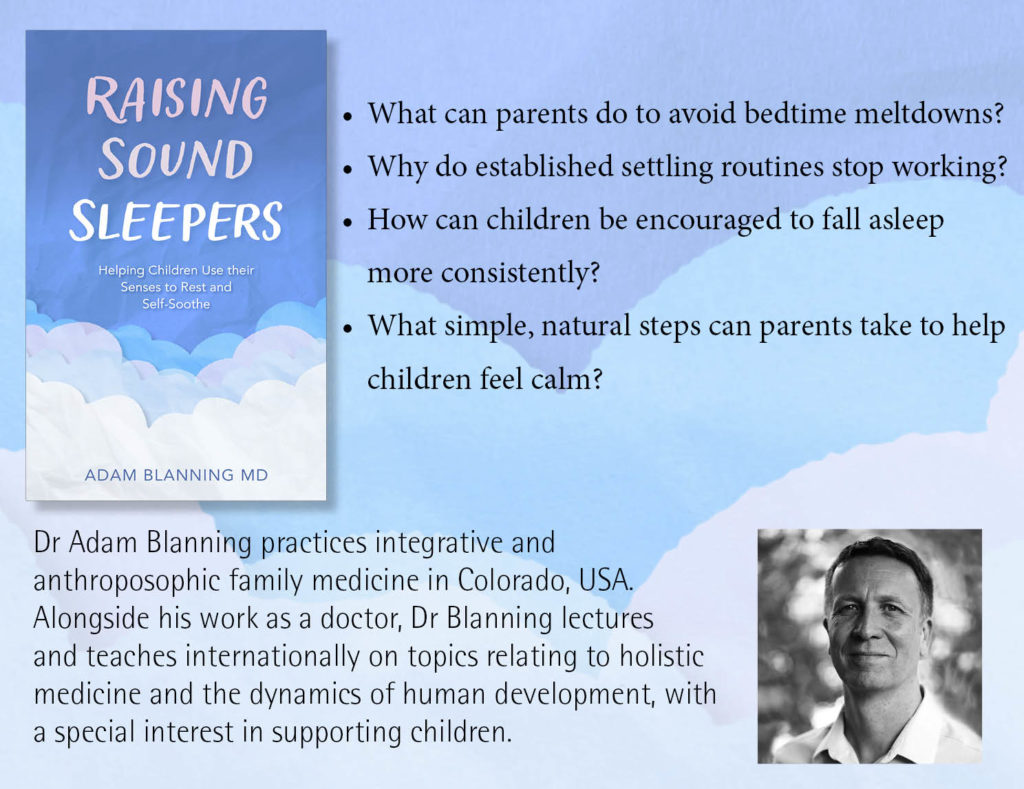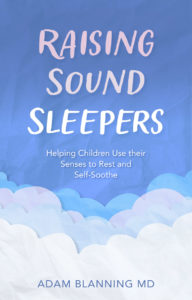Top Tips for Ending Bedtime Despair!
by Floris Books • 18 January 2023 • Extract, Parenting • 0 Comments

Sleep. For new parents especially, it can often be the thing of dreams, and when you find a solution the world feels that little bit brighter again. But what can you do when your child’s usual bedtime routine isn’t working anymore?
In Raising Sound Sleepers: Helping Children Use Their Senses to Rest and Self-Soothe Dr Adam Blanning offers practical ways in which parents and carers can support children to use their senses – from taste, smell and touch, through to balance and movement – to self-soothe, sleep and ultimately build resilience for life.
Dr Blanning explores a range of methods for children of all ages, from newborns to teenagers, and tackles key parental concerns, including:
- Tips for settling toddlers who always say ‘No!’
- How to establish calming daily rhythms
- Ways to help children settle during times of anxiety
- Self-soothing techniques that can improve disruptive behaviour
In the extract below, Dr Blanning identifies Parental Bedtime Despair – that terrible moment when you realise that the sleep technique you were using, stops working – and shares practical steps to help you help your little ones get back to a restful night’s sleep.
The stutter-step: how a step backward can become a step forward
There is a certain part of parenting that is particularly frustrating, and it is universal. It sneaks up on us at particularly vulnerable times and leads to PBD – Parental Bedtime Despair. This may not be a true clinical diagnosis, but it is certainly a true experience when our carefully practiced sleep technique goes bust. It’s usually unexpected and happens when we feel we have finally figured out how to reliably get our children to go to sleep. Having a child who consistently sleeps becomes not just a relief, but a triumph! (Especially after an extended period of sleep deprivation.) But then our soothing technique starts to lose its efficacy and you come down with a bad case of PBD.
There are several variations of this.
A common one in the first months of life goes like this. You’ve figured out that your child will predictably fall asleep as long as they are resting on your chest. It’s a relief to have found an effective soothing method, but then you find that you are stuck. You can’t move, literally. As soon as you start to shift your position, the baby wakes up. With an infant that is perhaps not such a big deal – you can put them in a carrier and still get a lot of other things done while they sleep. But as a child gets bigger, having them need to continually lie on your chest the entire time they are asleep becomes cumbersome. Your child grows too big to comfortably carry, but you still desperately need the young one to restfully sleep.
Something similar can occur when your child is older. You can get your child to fall asleep, but as soon as you slip away from their bedside, they wake up in distress. Now the whole soothing process has to start again. This makes bedtime a long process. Sometimes it even becomes a mutual bedtime, where tired parents lie down and also fall asleep. Then they wake some hours later and move to their own bed, although this may only be a temporary respite if their child wakes in the night and comes to get into bed with them.

A third variation is that your child will predictably go to sleep if you gently rub their back, but as soon as you stop stroking, they wake up. You find that, whereas previously you only needed to scratch or rub their back for 1–2 minutes, now you are required to sit there and rub for 10 minutes, 20 minutes, or even more.
In each instance, something that previously worked well starts losing its efficacy and as a parent you feel stuck.
What can you do? Your first thought might be to comfort your child for longer. This is a very common approach to the problem, especially when, as a parent, you are incredibly tired. You give more cuddling, longer backrubs, more songs, an extra story. This is a natural instinct; after all, providing loving comfort and reassurance is a core part of parenting. But so too is helping your child take a step towards more independent self-soothing at the appropriate time. I have spoken with families who stay only with that first approach, continually adding more steps, and end up with a 2-hour bedtime routine. But the very long bedtime actually ends up decreasing the total amount of time a child sleeps.
Most of the time both the child and the parents feel frustrated that things are not working as well as they used to. The child also wants to find a new and better way to settle. Even though you may fear that making a change will lead to more disruption and less sleep, a good next step is to shift your bedtime routine and do less.
As the parent, you have probably been doing 95% of the soothing process to get your child to go to sleep. Now you need to step back to about 70–80%, which means more of the process is being given to your child as a practice space. This does not mean abandoning your child, but it does mean doing a slightly different parenting job. Your task now is to focus more on providing a good rhythm and a consistent routine for quieting at the end of the day, but it is no longer solely your responsibility to make your child go all the way to sleep.

What does this look like, in practical terms, from the parenting side? It can be simple. In the first few months of life, it means not always nursing or bottle-feeding your child all the way to sleep. Instead, feed them until they are settled and calm but still awake, and then let them try doing the last 10–20% of the calming/sleeping process. Here is the sequence: feed (taste) to a point of satiated, calm wakefulness, then put your child down to fall asleep (not yet completely asleep). If they stir or make a sound, let them be for a few minutes. You have just opened a space for your child to not be solely reliant on taste for soothing. That’s a life skill!

If your child is older and you have been lying with them until they fall asleep, once they are tucked in, you can move to a chair, away from the bed, and sing a lullaby or talk about a favorite memory. Close contact (which invariably involves the senses of smell and touch) helped signal that it is time to settle, but now you have opened a space for your child to practice the last part of the self-soothing process. You let them know it’s time to get ready – putting on their pyjamas, brushing their teeth, reading them a story, giving them a cuddle and tucking them into bed (probably a good two-thirds of the bedtime routine) – and now you create a space for them to do the rest. After a period of adjustment your child will take on this self-soothing practice and move into a new phase.
Raising Sound Sleepers is an invaluable resource that will empower parents and carers to guide children towards rest, sleep and feeling calm – skills that will last a lifetime.

Looking for more helpful tips for parents? Join our Parenting & Child Health mailing list now for exclusive discounts, extracts from our insightful parenting books and information on our new books.